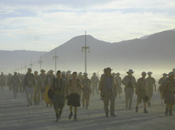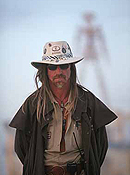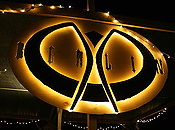Black Rock Rangers are Burning Man participants who volunteer time and effort as non-confrontational community mediators. Responding to the continuously evolving nature of the event, Rangers address situations within the community that would otherwise require outside intervention.
The Black Rock Rangers are, first and foremost, members of the community. The cadre of volunteers, identified by khaki-colored uniforms and white hats, represents a large cross-section of society and reflects the myriad of unique individuals who venture to the desert each year to participate in our novel and challenging exercise in temporary community. Rangers come from all over the U.S. and across the globe.
The Rangers are led by a Department Head who is advised by a team of senior rangers called the BRanger Operations Team (Ranger OPS). Together they address operational issues within the Ranger organization. A Ranger Council is responsible for addressing all organizational and administrative tasks required to support Ranger Operations throughout the year both off playa and in Black Rock City. Included in Ranger Council are four Rangers At Large (R.A.L.), members of the Ranger community selected by Council to participate on a higher level.
It is important to note that the Black Rock Rangers are not law enforcement personnel. However, because Black Rock City stands at the intersection of several legal jurisdictions (represented on the playa by the Pershing County Sheriffs Department, the Washoe County Sheriffs Department, Bureau of Land Management Law enforcement, Nevada State Highway Patrol, and other Nevada state agencies), Black Rock Rangers are at times required to interface with law enforcement personnel when event permit obligations require. In addition to event rules such as the no vending policy, prescribed speed limits, and ban on firearms, Black Rock City is also subject to the same laws that govern public conduct in any Nevada city. Black Rock Rangers work cooperatively with law enforcement groups in dealing with criminal conduct such as theft, assault, domestic violence and child abuse. Every year Black Rock Rangers call on law enforcement to help with a very small number of evictions or to deal with violent behavior.
Fifteen years ago, a Black Rock City citizen ventured out into the playa in search of wandering participants who had lost their way. That simple act of concern was the genesis of the Black Rock Rangers. Using a unique blend of non-confrontational mediation and chaos technician’s skills, the Rangers have become the primary enablers of Black Rock City’s growing population. Rangers’ numbers have scaled to meet the needs of the growing city, bringing fresh perspectives of new members to mesh with the wealth of experience that senior Rangers offer. The Rangers have grown and adapted each successive year as the city has evolved into the contemporary burn-topian art-tropolis it is today.
On-Playa
In an attempt to ease the burden on Ranger volunteers, shorter six-hour shifts in the early days of the 2006 event were implemented. Although the shorter shifts were welcomed by the Ranger volunteers, the addition of one shift per day increased management overhead for shift leads and HQ staff. Experiences with the six-hour shift will be analyzed in preparation for Burning Man 2007.
Overall Ranger morale was high in 2006. A number of new and enthusiastic Rangers stepped up and assumed greater responsibilities, complementing the dedicated crew of returning Rangers. This is an important development as new blood is vital to the Ranger organization. As with many Burning Man departments, the Rangers experienced some degree of burnout early in the 2006 event, perhaps contributing to reduced numbers working later in the week.
With too few Rangers responsible for much of the 2006 work pre-event and during the Burn, Rangers look forward to spreading the load more evenly in 2007 with new positions within the Rangers. Also, to better manage growing numbers, additional Volunteer Coordinators will be recruited for 2007. Rangers also eagerly anticipate increased female leadership positions.
As the scale of Black Rock City and the various large-scale events and installations grow each successive year, it becomes increasingly important that the individual Black Rock Ranger maintains a level of fitness to meet the increasing physical demands of “a shift in the dirt.”
Rangers and the Law
The Black Rock Rangers continued to strengthen the positive relationship with outside Law Enforcement Agencies in 2006, building on the trust earned in previous years. Law Enforcement Officers (LEOs) gained a greater level of trust in the Rangers’ organizational structure and sought the assistance of Shift Leads and Officers-of-the-Day by role, rather than seeking out individuals. The Rangers are pleased to report no major legal actions in 2006, the most successful year ever working with LEOs. Additionally, the Bureau of Land Management (BLM) Rangers and Black Rock Rangers worked closely together to resolve issues, each stepping up when appropriate and required. In 2006 combined federal and state arrests in Black Rock City significantly decreased.
Echelon and Logistics
This year, infrastructure of the Ranger organization on-playa benefited from the lessons learned at previous events. The Ranger Echelon crew worked tirelessly with the set-up crew to get the outposts and headquarters (HQ) set up in record time.
The Rangers continued to streamline and modernize systems and procedures in 2006. Pre-event, the Rangers went through a major revamping of online shift signup system to insure shift coverage pre-event. The new system worked well, and was fully integrated into the Ranger Headquarters shift-sign-in/sign-out system. Additionally, there was a high rate of compliance as most people showed up for the shifts to which they committed. Good data was produced this year as to which Rangers worked which shifts, and remaining system bugs will be worked out as the 2007 event approaches.
The year 2006 also brought the first version of a new application to track Ranger shift logs in a database, in an attempt to replace the reams of paper used in previous years and make the shift log data more accessible on the playa. The application looks good and will hopefully be put to better use in 2007.
Ranger Headquarters computers are modern and functional (if a little dusty), and as of 2006 are now fully battery-backed (after suffering due to power losses in previous years). For the second year, the addition of bar codes and scanners eased the check-in/check-out process, though some Rangers continue to forget to do one or the other.
Future plans for Ranger technology systems include a workstation in the shift lead area to make the new shift log application more useful, and a permanent system in the mobile command post to remove the need for personal laptop use. Further upgrades and feature requests to the shift sign-up/ Ranger office applications will be handled, as that system continues to mature and become more efficient and useful.
Aside from technological enhancements, some improvements to the Center Camp Ranger HQ are necessary to ensure the safety of those working there, often unaccompanied, late at night. This year, two unfortunate incidents of violence against Rangers at HQ illustrated the need for better lighting and improved layout to make HQ less of a “chill space” and more of a logistical hub.
Black Rock City’s 2006 early arrival policy caused more than a few problems for the Rangers as many, accustomed to arriving early, found themselves subject to stricter pre-event admission criteria. A much better policy implementation is in the works for 2007.
Training and Mentoring
As Ranger numbers grow, it is increasingly apparent that the Black Rock Rangers need to update and revamp training methods and materials. In 2006 numerous trainings were well attended across North America including a mid-July playa training and an event training the Sunday before Black Rock City’s gates opened.
In spite of an intensive one day training and a comprehensive manual available both in hard copy (at the trainings) and online, many new Rangers found themselves not knowing key policies and procedures during the event, even to the point of not recognizing the chain of command. Additionally, many senior Rangers were not abiding by mandated policies, choosing instead to revert to past practices (when Burning Man was a much smaller and less complicated event).
The goal for 2007 will be to improve the quality and emphasis of training materials and methods to resolve these unfortunate gaps in knowledge, and to reinforce this knowledge through the mentoring program.
Safety: Dangerous Art
Each year the scale and complexity of Black Rock City’s artwork provides new and unique safety challenges to the Rangers. Through the hard work and guidance supplied by the Performance Safety Team, fire artists are taking on most of the responsibility for their own safety perimeters, with Rangers acting as a resource and backup rather than primary guardians. More burning art and events early in the week helped spread the fun out and reduced the demands on the Rangers during the busy final weekend of Burning Man. Once again, the Flaming Lotus Girls proved an outstanding example of self-directed perimeter and safety procedures.
The immolation of the Burning Man on Saturday night proved a tremendous challenge for the Rangers staffing the perimeter. As in past years, the massive crowds and party atmosphere of The Burn was anticipated. This year however, two factors combined to present the Rangers with a new crowd management problem.
The first factor to consider is that the base of The Man has become larger, more complex and better built each year. As a result, The Man base burns slowly and takes longer to collapse. In the past, the Burning Man tradition has been for participants to rush to the fire as the Man falls. In recent years, this has proven problematic as the base takes longer and longer to burn and collapse safely. This causes crowd-control situations on the perimeter.
The second factor is the increasing number of laminated Fire Performers who remain inside the perimeter following the pre-burn festivities. These performers are well inside the safety perimeter making them difficult to control. This year, the Fire Performers rushed towards the fire as the Man fell before the “all clear” had been given and in spite of the fact that the burning Man base still presented a significant collapse hazard to those nearby. Many participants followed the Fire Performers causing a chain-reaction that led to the pre-mature collapse of the perimeter.
The hope for the future is to have the base engineered so that the entire structure collapses with the fall of the Man, in addition to greatly reducing the number of laminated guests and performers within the safety perimeter.
In stark contrast to the perimeter challenges of Saturday night, Sunday night saw a well-organized Ranger team form and hold three major perimeters in succession including the traditional Temple burn and the massive Uchronia fire, the largest burn (and perimeter) in Black Rock City to date. Additionally, the Rangers were faced with the challenge of finding a missing child in the midst of the Uchronia burn and utilized innovative techniques involving art-car sound systems, group radio broadcasts and crowd participation to locate the child.
Safety: Vehicle Intercept
Increased depth and experience within the Rangers’ Intercept Team proved valuable during another challenging year of educating participants about Black Rock City’s motorized vehicle regulations. On a positive note, the Rangers’ Intercept Team’s mobile command post had a wireless connection from beyond The Man back to Center Camp for the first time in 2006, which made it possible for Intercept to check the DMV database in real-time during interactions with mutant vehicles on the playa.
This year, the tow truck was inoperable and not present on the playa. A lack of a tow truck to remove offending vehicles to long-term parking definitely reduced the ability of the Intercept Team to implement the vehicle enforcement program.
Ranger Community
In 2006, there was an increase in the number of Rangers camping in close proximity to the 9 and 3 o’clock outposts. The increase in the number of ambient rangers living in these areas has done a great deal to improve the ability to support the will of the people and keep things flowing smoothly.
This year Outpost Toyko (9 o’clock plaza) had about 25 Rangers camped directly in the theme camp area and another 8-10 within a one block radius. Behind the “official” Ranger outpost tent and shade structure, Tokyo included a community bar and numerous chill spaces to get out of the heat of the day or get mesmerized by the lighting.
Outpost Berlin (3 o’clock plaza) also had about 25 Rangers camped there, which is a dramatic increase over previous years. In addition to the outpost shade structure there were communal social areas designed to further the good will and general love of the event to all those around that area, Rangers and neighbors alike. Additionally, enclaves of Rangers were scattered throughout Black Rock City and proved to be a very good resource to the greater community, both in survival/event knowledge and in the ability to get help with just a simple radio call. These resources also have been available when things get really busy and the Rangers need more bodies for a short period of time. All-in-all a huge asset to the continued smooth running of the event.
In addition to the growing communities at the 3 and 9 o’clock outposts, Center Camp now enjoys an evolving enclave of resident Rangers living along the 6 o’clock radial. Camp Howzit is home to some of Black Rock City’s dustiest and brings the art of Rangering to the downtown community.
Rangers, once again, made a huge effort to spread understanding and get to know volunteers from other departments, including, but not limited to: Gate, ESD, DPW and Lamplighters—organizations with a common love for the event and its smooth operation. Years of inter-department rivalry are slowly fading into the background, and with continued work, someday all of the easily avoidable misunderstandings will be a thing of the past.
Summary
In spite of continued growing pains and challenges presented by increased population and changing perceptions of participants, 2006 was a very successful year for the Black Rock Rangers. The Rangers look forward to implementing lessons learned in the past year and contribute towards making Burning Man 2007: The Green Man the most successful burn ever.
Submitted by,
Zac Bolan, AKA Ranger Disko




